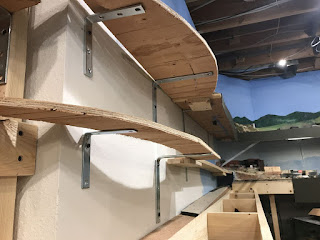First New Track Laid!
The Great Northwestern Railway is pleased to announce the first new track has been laid in the long-awaited Onava Cut-Off project. "This new line will provide a direct route between Chloride and Warm Springs, offering improved service throughout the GNW system." Although it requires a stiff 3.5 percent grade, the cutoff will allow crews to follow their trains over the scenic NM hills surrounding Onava, as well as connect with a previously islanded mining railroad. "The increased car loading alone justified the expense of the work," said one high-ranking GNW officer.
The cut-off required considerable design investment. The integration of the existing system with the new line resulted in one section of line where 4 separate grades have to be built directly over each other. "A lot of consultants recommended conventional benchwork, or even the elusive 'L-girder' construction. We elected to go avant-guarde: L-brackets. "Yes, looks unconventional. But offers incredibly strong support, minimal clearance issues, low cost, and quick construction." The same engineer commented that "they are largely adjustable, allowing modification of the grade as needed to get an even climb." This will be critical to allow the freight to roll. Even with the unconventional design, minimum radius of 30" was maintained, even around the 'great bend.'
The cut-off required considerable design investment. The integration of the existing system with the new line resulted in one section of line where 4 separate grades have to be built directly over each other. "A lot of consultants recommended conventional benchwork, or even the elusive 'L-girder' construction. We elected to go avant-guarde: L-brackets. "Yes, looks unconventional. But offers incredibly strong support, minimal clearance issues, low cost, and quick construction." The same engineer commented that "they are largely adjustable, allowing modification of the grade as needed to get an even climb." This will be critical to allow the freight to roll. Even with the unconventional design, minimum radius of 30" was maintained, even around the 'great bend.'
The next major breakthrough the design team accomplished was the development of low-cost sub-roadbed. "In the past we had to buy acres of homasote. Well, that stuff is expensive, and getting hard to find. Besides, the world just ain't flat. So we were constantly having to hack it up to get the topography we wanted. Instead we went to "Homex" strips. These are 10' long, 3-1/2" wide and a 1/2" thick. At first we just tried kerfing them to make the bend.
We violated a few EPA rules with the dust that was created. So one of our crack engineers came up with the idea of ripping them into strips, including putting an angle on some. This made them flexible enough to conform around the curves, provided a nice subgrade for cork and track, and was very cost effective.
Biggest issue is the Homex is not very dimensionally consistent, especially in thickness. The engineering team is still working on a solution for that. In the interim, track crews proceeded in laying cork and track.
"Ya, it took us a while to tie into the old work. Some of that track has been around since the early days. But once we got the tie-ins going, work went pretty quickly. We had to set up a standard for power feeders. We landed on power feeds ever other section, and allowing the joints in between to stay unsoldered and float, allowing for expansion and contraction." Some of the crews are not so convinced. "Back in the day, we would solder ever'thin'!" But times change, and so do construction techniques.
Tracks are now reaching the outskirts of Onava. Separate crews have been working from Black Water Falls back as well, with the intention of meeting up at Onava proper. "Business has been terrible up here at the resort! GNW management should have at least provided bus service while the railroad is down. We are considering legal action to cover the impacts this so-called improvement has had on us. We are losing customers!" GNW management commented that while the resort is a major attraction, as well as a major revenue source for the Colorado & Southern Scenic Railroad, they don't have any legal obligation to provide service. "We are doing the best we can. Once the line is complete, we will do everything we can to restore operations as soon as we can. In fact, we have crews lined up already, ready to go once the line is operational. We expect the BWF resort to see increased revenues due to the new scenic line. It really will be an attraction!"













Looking good Detlef! Can't wait to operate on the new areas.
ReplyDelete